Related Research Articles
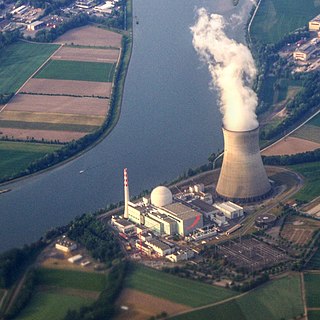
Nuclear power is the use of nuclear reactions to produce electricity. Nuclear power can be obtained from nuclear fission, nuclear decay and nuclear fusion reactions. Presently, the vast majority of electricity from nuclear power is produced by nuclear fission of uranium and plutonium in nuclear power plants. Nuclear decay processes are used in niche applications such as radioisotope thermoelectric generators in some space probes such as Voyager 2. Generating electricity from fusion power remains the focus of international research.
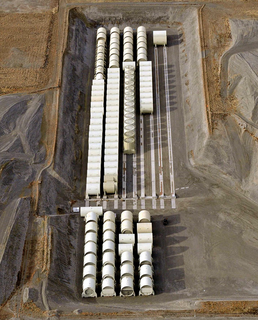
United States naval reactors are nuclear reactors used by the United States Navy aboard certain ships to generate the steam used to produce power for propulsion, electric power, catapulting airplanes in aircraft carriers, and a few more minor uses. Such naval nuclear reactors have a complete power plant associated with them. All U.S. Navy submarines and supercarriers built since 1975 are nuclear-powered by such reactors. There are no commissioned conventional (non-nuclear) submarines or aircraft carriers left in the U.S. Navy, since the last conventional carrier, USS Kitty Hawk, was decommissioned in May 2009. The U.S. Navy had nine nuclear-powered cruisers with such reactors also, but they have since been decommissioned. Reactors are designed by a variety of contractors, then developed and tested at one of several government owned and prime contractor-operated facilities: Bettis Atomic Power Laboratory in West Mifflin, Pennsylvania and its associated Naval Reactors Facility in Idaho, and Knolls Atomic Power Laboratory in Niskayuna, New York and its associated Kesselring site in West Milton, New York, all under the management of the office of Naval Reactors. Sometimes there were full-scale nuclear-powered prototype plants built at the Naval Reactors Facility, Kesselring, and Windsor to test the nuclear plants, which were operated for years to train nuclear-qualified sailors.

Hyman G. Rickover was an admiral in the U.S. Navy. He directed the original development of naval nuclear propulsion and controlled its operations for three decades as director of the U.S. Naval Reactors office. In addition, he oversaw the development of the Shippingport Atomic Power Station, the world's first commercial pressurized water reactor used for generating electricity. Rickover is also one of four people who have been awarded two Congressional Gold Medals.

The Atomic Age, also known as the Atomic Era, is the period of history following the detonation of the first nuclear weapon, The Gadget at the Trinity test in New Mexico, on July 16, 1945, during World War II. Although nuclear chain reactions had been hypothesized in 1933 and the first artificial self-sustaining nuclear chain reaction had taken place in December 1942, the Trinity test and the ensuing bombings of Hiroshima and Nagasaki that ended World War II represented the first large-scale use of nuclear technology and ushered in profound changes in sociopolitical thinking and the course of technological development.
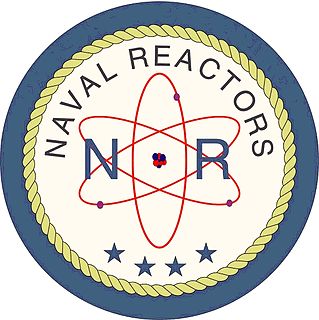
Naval Reactors (NR), also known as the Naval Nuclear Propulsion Program, is an umbrella term for the U.S. government office that has comprehensive responsibility for the safe and reliable operation of the United States Navy's nuclear propulsion program. A single entity, it has authority and reporting responsibilities within both the United States Department of the Navy and the United States Department of Energy in its National Nuclear Security Administration.
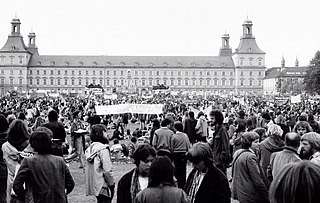
The anti-nuclear movement is a social movement that opposes various nuclear technologies. Some direct action groups, environmental movements, and professional organisations have identified themselves with the movement at the local, national, or international level. Major anti-nuclear groups include Campaign for Nuclear Disarmament, Friends of the Earth, Greenpeace, International Physicians for the Prevention of Nuclear War, Peace Action and the Nuclear Information and Resource Service. The initial objective of the movement was nuclear disarmament, though since the late 1960s opposition has included the use of nuclear power. Many anti-nuclear groups oppose both nuclear power and nuclear weapons. The formation of green parties in the 1970s and 1980s was often a direct result of anti-nuclear politics.

Nuclear power in the United States is provided by 92 commercial reactors with a net capacity of 94.7 gigawatts (GW), with 61 pressurized water reactors and 31 boiling water reactors. In 2019, they produced a total of 809.41 terawatt-hours of electricity, which accounted for 20% of the nation's total electric energy generation. In 2018, nuclear comprised nearly 50 percent of U.S. emission-free energy generation.

Nuclear power is since the mid 1980s the largest source of electricity in France, with in 2019 a generation of 379.5 TWh and a total electricity production of 537.7 TWh. In 2018, the nuclear share was 71.67%, the highest percentage in the world.

The Nuclear Information and Resource Service (NIRS) is a 501(c)(3) non-profit anti-nuclear group founded in 1978 to be the information and networking center for citizens and organizations concerned about nuclear power, radioactive waste, radiation and sustainable energy issues. The organization advocates the implementation of safe, sustainable solutions such as energy efficiency, solar power, wind power and plug-in hybrids.
Nuclear history of the United States describes the history of nuclear affairs in the United States whether civilian or military.
Nuclear power is the fifth-largest source of electricity in India after coal, gas, hydroelectricity and wind power. As of November 2020, India has 22 nuclear reactors in operation in 7 nuclear power plants, with a total installed capacity of 7,380 MW. Nuclear power produced a total of 43 TWh in 2020-21, contributing 3.11% of total power generation in India. 10 more reactors are under construction with a combined generation capacity of 8,000 MW.

The anti-nuclear movement in the United States consists of more than 80 anti-nuclear groups that oppose nuclear power, nuclear weapons, and/or uranium mining. These have included the Abalone Alliance, Clamshell Alliance, Committee for Nuclear Responsibility, Nevada Desert Experience, Nuclear Information and Resource Service, Physicians for Social Responsibility, Plowshares Movement, Women Strike for Peace, and Women's International League for Peace and Freedom. The anti-nuclear movement has delayed construction or halted commitments to build some new nuclear plants, and has pressured the Nuclear Regulatory Commission to enforce and strengthen the safety regulations for nuclear power plants.
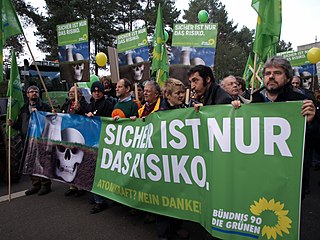
The anti-nuclear movement in Germany has a long history dating back to the early 1970s when large demonstrations prevented the construction of a nuclear plant at Wyhl. The Wyhl protests were an example of a local community challenging the nuclear industry through a strategy of direct action and civil disobedience. Police were accused of using unnecessarily violent means. Anti-nuclear success at Wyhl inspired nuclear opposition throughout Germany, in other parts of Europe, and in North America. A few years later protests raised against the NATO Double-Track Decision in Germany and were followed by the foundation of the Green party.
Arjun Makhijani is a nuclear engineer who is president of the anti-nuclear organization, the Institute for Energy and Environmental Research. Makhijani has written reports analyzing the safety, economics, and efficiency of various energy sources.
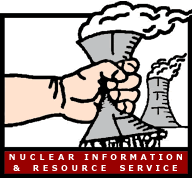
More than 80 anti-nuclear groups are operating, or have operated, in the United States. These include Abalone Alliance, Clamshell Alliance, Greenpeace USA, Institute for Energy and Environmental Research, Musicians United for Safe Energy, Nevada Desert Experience, Nuclear Control Institute, Nuclear Information and Resource Service, Public Citizen Energy Program, Shad Alliance, and the Sierra Club. These are direct action, environmental, health, and public interest organizations who oppose nuclear weapons and/or nuclear power. In 1992, the chairman of the Nuclear Regulatory Commission said that "his agency had been pushed in the right direction on safety issues because of the pleas and protests of nuclear watchdog groups".
Padmanabhan Krishnagopala Iyengar, was an Indian nuclear physicist who is widely known for his central role in the development of the nuclear program of India. Iyengar previously served as the director of BARC and former chairman of the Atomic Energy Commission of India, he raised his voice and opposition against the nuclear agreement between India and the United States and expressed that the deal favoured the United States.
National nuclear energy policy is a national policy concerning some or all aspects of nuclear energy, such as mining for nuclear fuel, extraction and processing of nuclear fuel from the ore, generating electricity by nuclear power, enriching and storing spent nuclear fuel and nuclear fuel reprocessing. Nuclear energy policies often include the regulation of energy use and standards relating to the nuclear fuel cycle.

The international reaction to the 2011 Fukushima Daiichi nuclear disaster has been diverse and widespread. Many inter-governmental agencies responded to the Japanese Fukushima Daiichi nuclear disaster, often on an ad hoc basis. Responders included International Atomic Energy Agency, World Meteorological Organization and the Preparatory Commission for the Comprehensive Nuclear Test Ban Treaty Organization, which has radiation detection equipment deployed around the world.

The nuclear energy policy of the United States began in 1954 and continued with the ongoing building of nuclear power plants, the enactment of numerous pieces of legislation such as the Energy Reorganization Act of 1974, and the implementation of countless policies which have guided the Nuclear Regulatory Commission and the Department of Energy in the regulation and growth of nuclear energy companies. This includes, but is not limited to, regulations of nuclear facilities, waste storage, decommissioning of weapons-grade materials, uranium mining, and funding for nuclear companies, along with an increase in power plant building. Both legislation and bureaucratic regulations of nuclear energy in the United States have been shaped by scientific research, private industries' wishes, and public opinion, which has shifted over time and as a result of different nuclear disasters.

Long one of the world's most committed promoters of civilian nuclear power, Japan's nuclear industry was not hit as hard by the effects of the 1979 Three Mile Island accident (USA) or the 1986 Chernobyl disaster (USSR) as some other countries. Construction of new plants continued to be strong through the 1980s and into the 1990s. However, starting in the mid-1990s there were several nuclear related accidents and cover-ups in Japan that eroded public perception of the industry, resulting in protests and resistance to new plants. These accidents included the Tokaimura nuclear accident, the Mihama steam explosion, cover-ups after accidents at the Monju reactor, and the 21 month shut down of the Kashiwazaki-Kariwa Nuclear Power Plant following an earthquake in 2007. Because of these events, Japan's nuclear industry has been scrutinized by the general public of the country.
References
- ↑ Uncertainty Surrounds Plans for New Nuclear Reactors,
- ↑ "Anti-Nuclear Advocates Receive JBL Awards from Tides Foundation". PR Newswire . 2008-07-21. Archived from the original on 2011-06-04.
